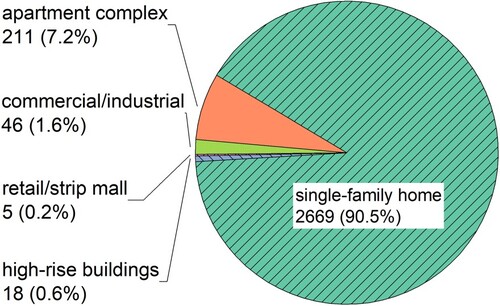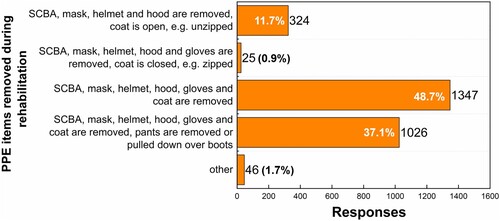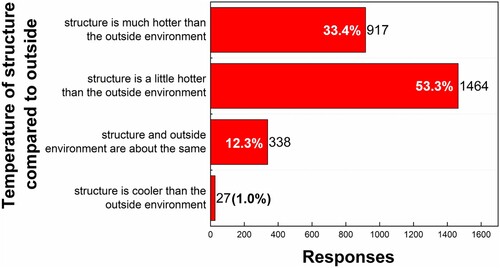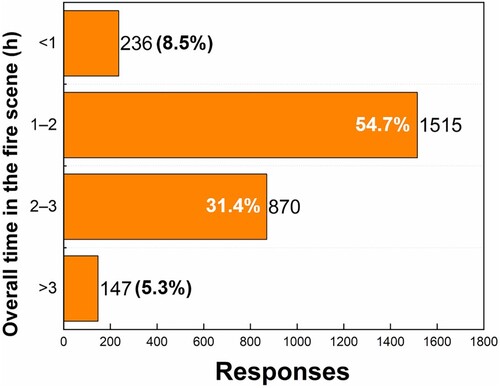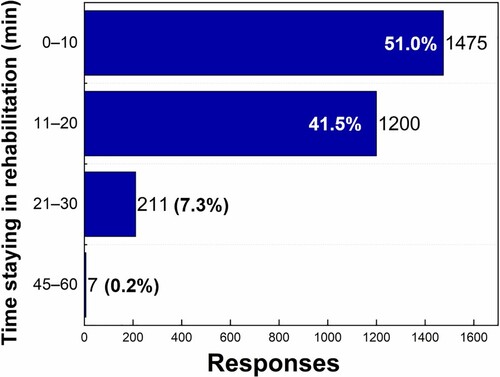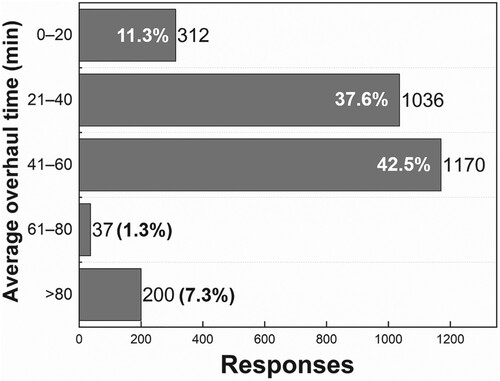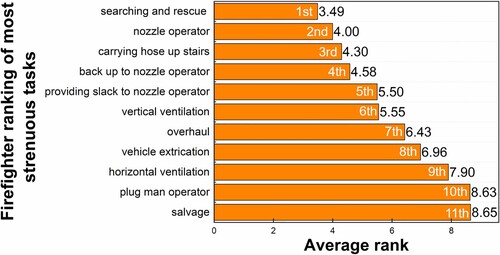Abstract
This article describes results from a survey of firefighters designed to identify conditions that contribute to heat strain in structural firefighting. Based on responses from about 3000 firefighters across the USA and Canada, the article provides invaluable information about how firefighters associate environmental conditions, work tasks and other factors with heat strain. One-half of firefighters surveyed have experienced heat stress during their service. They can wear fully deployed turnout gear for 2 h or more at the fire scene, reinforcing the importance of turnout suit breathability as a factor in heat strain. Survey results are useful in weighing the comparative value of total heat loss (THL) and evaporative heat resistance (Ref) for predicting turnout-related heat strain. Survey findings support the inclusion of a performance criterion in the National Fire Protection Association 1971 standard for firefighter personal protective equipment based on limiting Ref of turnout materials along with current THL requirement.
1. Introduction
The lack of breathability of materials used in the construction of firefighter’s turnout gear is an essential contributor to firefighter heat strain [Citation1–4]. Sweating hot plate test methods provide heat strain indexes for predicting the effects of the performance of turnout suit materials [Citation1,Citation5–7]. Current interest exists in evaluating the merits of using measures of total heat loss (THL) or evaporative resistance (Ref) as the basis of the National Fire Protection Association (NFPA) 1971 and ASTM F1868 performance requirements for certifying turnout suits [Citation8,Citation9]. The ‘THL method’ measures heat loss through turnout materials into an environment set at 25 °C (77 °F) and 65% relative humidity (RH). Ref is an isothermal measurement of the ability of the turnout composite to dissipate heat through sweat evaporation into a warm ambient environment (35 °C or 95 °F and 40% RH). Improved understanding of the environmental and working conditions associated with firefighter heat strain in structural firefighting operations helps assess the value of THL and Ref indexes for rating turnout materials’ effect on firefighter heat strain [Citation10,Citation11].
Primary factors contributing to firefighter heat strain are hot and humid working environments and the high metabolic work rates associated with the tasks required in structural firefighting operations [Citation12–15]. Key variables include geographical and seasonal variations in outdoor climates, solar load and radiant heat from fires and the base layers worn with turnout gear, and the temperature and humidity of the fire engine cab on the way to the fire scene [Citation16–23]. Differences in firefighter conditioning and physiology, hydration level [Citation13,Citation24–26], rehab strategies [Citation26] and factors of firefighter response are an important determinant of heat strain [Citation27]. Therefore, we aimed to survey a large number of firefighters to obtain more information about the conditions that contribute to heat strain in all phases of structural firefighting response. We were particularly interested in the improved definition of the contribution of personal protective equipment (PPE) to firefighter heat strain.
2. Methodology
We employed a survey to better understand the factors contributing to heat strain across the full spectrum of firefighter operational response scenarios. We formulated questions in collaboration with the Fire Industry Education Resource Organization (F.I.E.R.O.). The North Carolina State University (NCSU) Institutional Review Board (IRB) and the Compliance Assurance Program Office (CAPO) of the Department of Homeland Security (DHS) approved the survey protocol. We surveyed firefighters throughout the USA and Canada. In 2018, we used the SurveyMonkey platform to gather respondent demographic data and gear and incident-specific information. We obtained information about factors that affect heat stress in structural firefighting operations. We sought to identify environmental and working conditions that firefighters associate with turnout-related heat strain.
We received responses from 2949 firefighters from locations across the USA and Canada. Responses came from firefighters from all geographical regions of the country. The firefighter responders hold different ranks, and had different years of service, as shown in Figure a. Most firefighters responding came from a career fire department (55.9%) and a significant number are members of a volunteer department (19.2%). A large proportion of the firefighters (21.1%) came from a department with both career and volunteer firefighters. As a population (Figure b), the firefighters who responded held various ranks and jobs in the fire department, including firefighters (40%), company officers (32.3%) and chief officers (20.2%). Approximately 75% had more than 10 years in the fire service (Figure c). Some (3.2%) of responding firefighters had more than 40 years of service. The average service time of the surveyed population is 19.1 years.
Figure 1. Survey demographics: (a) fire department type; (b) firefighter rank in the department; (c) years of service. Note: Based on 2949 responses.

The majority of firefighters surveyed were based in the USA; 2.1% were based in Canada (62 responses) (Figure a). More than half (56.5%) of US participants came from the eastern part of the nation. As shown in Figure b, the majority of survey responders (about 80%) identified their climate to be hot and humid during the summer months. Another 13.5% characterized their working climate as hot and dry. These geographic–climatic data are consistent with the geographic distribution of the surveyed group of firefighters from eastern and southern states. National Oceanic and Atmospheric Administration (NOAA) National Centers for Environmental Information data show that the summer climate temperature in these regions is above the annual national average, with relatively high relative humidity [Citation28].
Figure 2. (a) Service location and (b) climate during the summer months. Note: Based on 2949 responses).
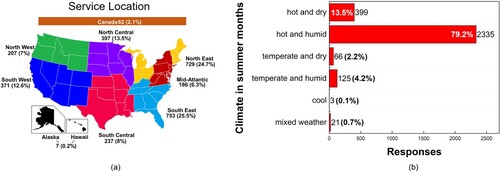
Figure shows that the most frequent fire service call is to single-family homes (90.5%), a result consistent with US Fire Administration (USFA) data [Citation29]. The type of building structure involved in the response is an important consideration for our survey, since it affects work duration and potential for firefighter heat strain.
3. Identifying factors contributing to heat strain in dynamic firefighting operations
Previous surveys on firefighter heat strain have focused on the time that firefighters spend performing strenuous work in fire suppression environments [Citation4,Citation21,Citation30–32]. Studies show that only a small percentage of firefighters’ working time is spent in fire suppression [Citation24,Citation33]. Surprisingly, little information is available on the conditions contributing to heat strain occurring throughout the firefighting process before, during and after fire suppression operations. This is an important consideration because structural firefighting operations involve dynamically changing environments and activities, where firefighters perform a variety of tasks in different environmental conditions.
The objective of our study was to answer the following fundamental questions:
What clothing and gear do firefighters wear in different phases of firefighting response?
When do firefighters typically put on their turnout suit and other gear?
How long do firefighters spend in different phases of response, from dispatch and transit to the fire scene and rehabilitation?
How long are they at the fire scene?
How long are they engaged in fire suppression and overhaul activities?
How many entries do they typically make into the burning structure?
What tasks do they consider the most physically demanding?
What is their perception of the environmental conditions in different phases of response?
Do they experience heat strain?
In what conditions and activities do they experience heat distress?
4. Results
4.1. Clothing and gear worn by firefighters
There can be little doubt that the thermal burden of the turnout suit can contribute to firefighter heat strain and related injuries. We obtained information about the clothing and PPE worn by the firefighters from the fire station and dispatched through active firefighting, overhaul and rehabilitation. Noticeably, besides PPE, clothing base layers also can play a role in heat exchange besides the thermal environment. Base garments worn under turnout gear affect the insulation and breathability of the protective clothing system due to the change in air space and moisture transfer capability [Citation21,Citation24,Citation34,Citation35]. Our survey, as summarized in Table , found that a short-sleeved t-shirt with long pants is the most commonly worn garment (44.6%) when firefighters are in the fire station. A short-sleeved t-shirt with shorts accounted for 25.7% of the survey responses. Some firefighters noted that they are likely to wear a short-sleeved t-shirt with shorts when responding to a fire call at night during the summer months. Regarding socks, most firefighters said that they wear a medium-weight crew sock.
Table 1. Garments worn under turnout gear in summer months.
After notification of a suspected working fire, firefighters typically put on their PPE before boarding the apparatus. As Table presents, most of them put on a turnout coat (79.2%), turnout pants (90.6%), a hood (76.9%) and boots (87.9%) during the short period before dispatch. As Figure shows, most firefighters wear a fully zipped turnout coat in transit.
Table 2. PPE items worn before and after getting into the apparatus when being notified of a suspected working fire.
While on the apparatus, 69.4% of responders put on self-contained breathing apparatus (SCBA). About 25% of them put on a helmet and gloves. The SCBA is typically attached to the seat. Firefighters just put on a rack in the apparatus during transit. Hence, SCBA weight does not contribute to firefighter load bearing until they arrive at the fire scene. This is an important consideration because the carried load can affect the firefighter’s metabolic rate and heat output [Citation36,Citation37]. To estimate the SCBA cylinder weight, we surveyed the cylinder size used. Figure shows that 60.3% of the firefighters say that they use 45-min bottles, while 34% use 30-min bottles.
Figure 5. Time duration of SCBA cylinders worn by firefighters. Note: Based on 2903 responses. SCBA = self-contained breathing apparatus.
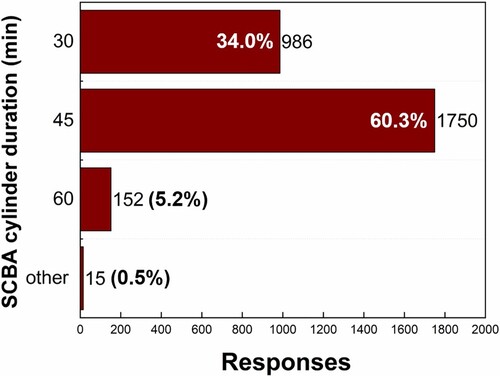
Firefighters usually wear their full PPE ensemble while actively engaging in direct firefighting operations. Noticeably, the survey indicated that most wear their full PPE during overhaul as well, as presented in Table , including a helmet (95.9%), a fully zipped turnout coat (87.5%), turnout pants (97.7%), gloves (97.2%), a hood (73.5%), SCBA (82.8%) and boots (97.4%). This is significant because overhaul is generally after the physically strenuous firefighting and itself also requires strenuous activities, such as the pull-down of burnt ceiling and walls. Meanwhile, wearing the full PPE may add significant heat strain to firefighters.
Table 3. PPE items worn during overhaul.
Firefighters rest and cool down, or rehabilitate, at different stages in the structural firefighting response, depending on their physiological condition. They may take breaks between entries into the fire, or after a long overhaul. Figure shows the PPE typically worn by firefighters during rest. Most firefighters remove their turnout coats. About one-third remove their bunker pants, or pull them down around their boots. A few firefighters say that they leave their bunker gear on, only unzipping their turnout coat.
4.2. Thermal environments encountered in firefighting operations
Firefighters universally associate heat strain with hot conditions. Hence, it is critical to understand the thermal environments at different phases of the whole firefighting process. We take summer days’ outdoor environment conditions as the control, and ask firefighters to qualify their perceptions of specific scenarios in comparison with the outside climate. This may, to some extent, help us to quantitatively estimate the thermal condition at different stages.
When in transit to the fire scene, most firefighters thought that the apparatus is about the same temperature as the outside environment (Figure a). However, most firefighters could feel the cooling effects of the air-conditioned interior of the apparatus before arriving at the scene (Figure b).
Figure 7. Firefighters’ perception of (a) apparatus interior climate compared to outdoor weather conditions during warmer months and (b) apparatus AC cooling effect in transit. Note: Based on 2917 responses. AC = air conditioning.
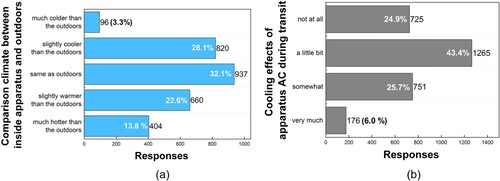
At the fire scene, inside the burning building, the environmental conditions encountered can vary greatly, depending on the fire conditions, locations and firefighters’ activities. Previous studies, using conditions present in live-fire training, have shown that active fire suppression can be extremely hot in burning structures [Citation13,Citation15].
During the overhaul, most firefighters (53.3%) said that the environment inside a burnt building is a little hotter than the outside (Figure ) and 33.4% believe the structure is much hotter. This demonstrates that even though the fire is out, the burnt structure may still have residual heat during overhaul operations, which may enhance the risk of heat strain at this phase.
4.3. Time firefighters spend in different activities in different thermal environments
Besides environmental heat and humidity, the amount of time that firefighters spend in different thermal environments, and the activities they perform in those environments, are key to understanding the factors that contribute to heat strain as well. Understanding these factors is equally important for establishing a real-world basis for selecting laboratory-testing conditions for certifying the heat strain performance of turnout gear.
Based on our survey, it typically takes less than 10 min for firefighters to transit from the station to the fire scene (Figure ). Thereafter, they usually stay at the scene for 1–2 h (Figure ). The work intensity that firefighters perform at the fire scene (from the time they arrive to the time they leave) is a crucial factor affecting heat stress. To understand how firefighters distribute their activities at the fire scene, we asked them to estimate the percentage of time they spent on actively firefighting in the burning structure, conducting physically demanding activities at the scene but outside the fire environment and conducting physically undemanding activities outside the fire environment. Figure shows that firefighters spent about 70% of their time doing physically demanding work inside or outside the burning structure. They spend the remainder of their time performing light activities outside the fire scene.
Figure 9. Average response time to a suspected working fire in summer months. Note: Based on 2917 responses.
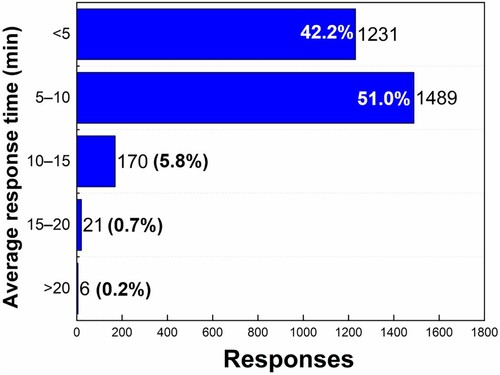
Figure 11. Distribution of time on scene by intensity of work activity. Note: Based on 2768 responses.
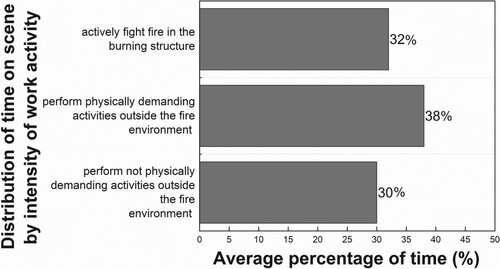
During active firefighting, depending on the departmental policy and the firefighter’s physical condition, firefighters usually enter the structure two or three times, with each entry taking about 10–20 min (Figure ), including a very short break. Studies have shown that re-entering a fire structure with repeated bouts of intense fire suppression activities contributes to increasing the firefighters’ body temperature [Citation13,Citation38].
Figure 12. (a) Re-entry times to a working fire after the first entry (based on 2893 responses) and (b) average time for SCBA EOSTI to go off (based on 2903 responses). Note: EOSTI = end-of-service time indicator; SCBA = self-contained breathing apparatus.
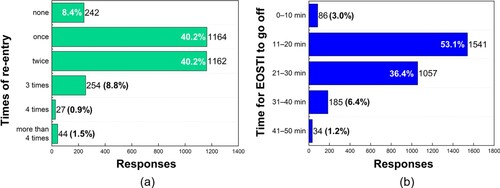
Figure shows the average time firefighters say they spend in rehabilitation before being cleared. The average time firefighters say they spend in rehabilitation is 12.3 min.
The estimated average time of overhaul is 45 min (Figure ). Overhaul is a more self-paced flexible stage than active firefighting. Some overhaul operations can take even longer than 1 h.
4.4. Work intensity in firefighting
Firefighting activities generate high levels of metabolic heat. The turnout suits must efficiently transmit the heat to avoid potential heat build-up and heat stress. Studies show that the high work rates produced by the physically demanding tasks required in structural firefighting are critical contributors to firefighter heat strain [Citation13,Citation39]. Furthermore, understanding the intensity of work activities helps design laboratory testing protocols for certifying the breathability of turnout suits. Hence, an important objective of this study was to identify tasks that firefighters consider the most strenuous.
Figure shows how survey responders rate the intensity of common work tasks, where a rating of ‘1’ represents the most physically demanding task. Based on these findings, firefighters rated tasks associated with search and rescue operations as the most strenuous, followed by nozzle operations and carrying a water hose upstairs. This is not a surprising result considering that they conduct emergency search and rescue operations in life-threatening circumstances with the present danger of fire. These emergency circumstances elicit maximum expenditure of physical energy. After tasks of hose operations, firefighters consider vertical ventilation and overhaul to be in the top five most strenuous activities in structural firefighting response. We note that they rated vehicle extraction, a task not included in structural firefighting, as the eighth most strenuous task they perform, lower in work intensity rating than most of the tasks required in structural firefighting operations.
4.5. Firefighters’ perception of conditions that cause heat stress
Almost one-half (47.2%) of surveyed firefighters said that they have suffered from heat exhaustion, heat stress or a related condition some time during their service. As reflected in examples of firefighter comments summarized in Table , most of the heat strain issues occurred when performing strenuous work in a hot and humid environment wearing full PPE. Most firefighters who experienced heat strain (993 of the firefighters mentioned ‘hot/high temperature’, ‘summer’, ‘90+ °F’, ‘100+ °F’ and ‘110+ °F’) cited hot and humid conditions as causative factors for heat distress. They associated perceived temperatures in the range 90–110 °F (32–43 °C). They described the conditions as being ‘humid’ or ‘high humidity’ in 422 of their responses. In comparison, just three firefighters out of the many who had experienced heat distress said it occurred in temperate conditions (about 70 °F or 21 °C). Only one firefighter surveyed experienced heat stress in cool weather.
Table 4. Typical firefighter comments on environmental conditions and activities that cause heat stress.
Overhaul is the operational stage when most firefighters said they experience heat distress. In this case, heat stress is often the outcome of a cumulative process resulting from metabolic heat generated by strenuous work in fire suppression. These activities accumulate with prolonged work in overhaul operations. This finding is consistent with studies that have characterized human heat strain in simulated structural fires [Citation13].
In addition, we believe there are significant effects of turnout suits on core temperature rise based on our reported simulations of human wear trials in different environmental conditions [Citation11,Citation40–42].
In summary, firefighters can experience heat exhaustion in all stages of firefighting, particularly when performing strenuous work in hot conditions such as dragging a hose upstairs or performing vertical ventilation on a hot roof in hot weather. Heat stress can occur when firefighters are conducting other operations, including vehicle extrication on a hot day or in training exercises (Table ). Our survey identified contributing conditions in different stages of structural firefighting, from the time the firefighter leaves the fire station through active firefighting to overhaul and rehabilitation (Figure ).
Figure 16. Factors affecting firefighter heat strain in an example response scenario to a structure fire. Note: AC = air conditioning; PPE = personal protective equipment; SCBA = self-contained breathing apparatus; NA = not applicable.
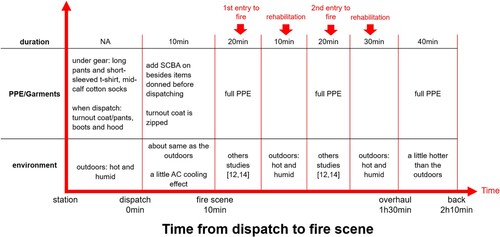
Firefighters consider some job assignments such as search and rescue, nozzle operation and carrying a hose upstairs to be particularly stressful. They associate multiple re-entries with heat exhaustion. Besides these major factors, many other variables can contribute to firefighter’s heart strain, such as putting on preheated gear, the adrenaline rush of a working fire alarm, solar load and the extra weight of carrying necessary tools. All of these factors either add additional heat to the firefighter or cause the body to produce more heat. For firefighters, heat stress is primarily a hot weather event. Nevertheless, heat stress is possible in cold climates if firefighters encounter extreme heat environments while fighting the fire, or if prolonged operations in cold weather produce heat build-up [Citation13].
5. Conclusions
This survey study has confirmed the importance of reducing turnout gear-related heat strain on firefighters. It showed that many firefighters (about 50%) experience heat stress while on the job. Heat stress can occur in different conditions and stress levels, but is most often associated with environmentally stressful (hot) conditions. It is associated with the cumulative effect of prolonged work activity in firefighter operations.
Firefighters believe that their gear contributes to heat stress. This survey of North American firefighters supports the need for Ref heat strain rating of turnouts in addition to a THL requirement. This is because Ref measures evaporative resistance of turnout materials in hot conditions. THL measures heat loss through turnout materials in mild environments. It has no proven value for predicting heat strain in hot environments [Citation11]. In view of these results, the inclusion of both Ref and THL heat strain requirements in the NFPA 1971 performance standard would contribute to reducing turnout-related firefighter heat strain in the dynamic multi-environmental conditions found in structural firefighting operations.
6. Caveat
The findings of this study do not represent specific firefighting response scenarios or conditions. Every fire scene is unique and presents different risks to firefighter safety. We are not attempting to recommend any particular operational tactics, gear selection, job assignment or rehabilitation routine. These are decisions best made by professional firefighters at the scene. We surveyed firefighters in North America, primarily located in the USA. Responses may be different for firefighters located in parts of the world that conduct firefighting operations in different climate ranges, use different firefighting tactics or wear gear certified to performance standards other than the NFPA 1971 standard for structural firefighter PPE.
Acknowledgements
The authors gratefully acknowledge the indispensable assistance of almost 3000 professional and volunteer firefighters from across North America for participating in the survey. They provided a perspective on conditions associated with heat stress that they are uniquely qualified to assess. The authors would like to acknowledge the significant contributions of the expert panel that advised this project. Many thanks to Dr David Evans and the support from the Assistance to Firefighters Grants (AFG) team. Finally, it is always the authors’ great hope that the findings of this study may contribute to benefit the safety and health of firefighters. All data included in this article are original.
Disclosure statement
No potential conflict of interest was reported by the authors.
Additional information
Funding
References
- Barker R. Evaluating the heat stress and comfort of firefighter and emergency responder protective clothing [Internet]. In: Song G, editor. Improving comfort in clothing. Cambridge (UK): Woodhead; 2011 [cited 2019 Apr 29]. p. 305–319. Available from: http://www.sciencedirect.com/science/article/pii/B9781845695392500120
- Ross K, Barker R, Deaton AS. Translation between heat loss measured using guarded sweating hot plate, sweating manikin, and physiologically assessed heat stress of firefighter turnout ensembles. In: Shepherd AM, editor. Performance of protective clothing and equipment. West Conshohocken (PA): ASTM International; 2012. p. 27–47. (Emerging issues and technologies; 9th vol.).
- Marszałek A, Młynarczyk M. Physiological tests on firefighters whilst using protective clothing. International Journal of Occupational Safety and Ergonomics. 2021;27:384–392. doi:10.1080/10803548.2020.1794370
- Fullagar HHK, Schwarz E, Richardson A, et al. Australian firefighters perceptions of heat stress, fatigue and recovery practices during fire-fighting tasks in extreme environments. Applied Ergonomics. 2021;95:103449.
- Gohlke DJ. History of the development of the total heat loss test method [Internet]. In: Performance of protective clothing: sixth volume; 1997 [cited 2019 Apr 29]. Available from: http://www.astm.org/DIGITAL_LIBRARY/STP/PAGES/STP19903S.htm
- Psikuta A, Rossi RM, Morrissey MP, et al. A new method to assess the influence of textiles properties on human thermophysiology. Part I: thermal resistance. Int Jnl of Clothing Sci & Tech. 2015;27:272–282. doi:10.1108/IJCST-02-2014-0020
- McQuerry M, DenHartog E, Barker R. Impact of reinforcements on heat stress in structural firefighter turnout suits. The Journal of The Textile Institute. 2018;109:1367–1373. doi:10.1080/00405000.2018.1423881
- National Fire Protection Association 1971 Standard on Protective Ensembles for Structural Fire Fighting and Proximity Fire Fighting. Quincy (MA): National Fire Protection Association; 2018.
- ASTM International. ASTM F1868 – 17 Test Method for Thermal and Evaporative Resistance of Clothing Materials Using a Sweating Hot Plate. West Conshohocken (PA): ASTM International; 2017.
- Gao H, Deaton AS, Fang X, et al. Effects of environmental temperature and humidity on evaporative heat loss through firefighter suit materials made with semi-permeable and microporous moisture barriers. Textile Research Journal. 2021;00405175211026537.
- DenHartog EA, Fang X, Deaton AS. Effects of total heat loss versus evaporative resistance of firefighter garments in a physiological heat strain trial [Internet]. In: Performance of protective clothing and equipment: innovative solutions to evolving challenges. West Conshohocken (PA): ASTM International; 2020 [cited 2021 Jan 7]. p. 204–221. Available from: https://www.astm.org/doiLink.cgi?STP162420190075
- Gledhill N, Jamnik VK. Characterization of the physical demands of firefighting. Can J Sport Sci. 1992;17:207–213.
- Horn GP, Kesler RM, Kerber S, et al. Thermal response to firefighting activities in residential structure fires: impact of job assignment and suppression tactic. Ergonomics. 2018;61:404–419. doi:10.1080/00140139.2017.1355072
- O’Connell ER, Thomas PC, Cady LD, et al. Energy costs of simulated stair climbing as a job-related task in fire fighting. J Occup Med. 1986;28:282–284.
- Willi JM, Horn GP, Madrzykowski D. Characterizing a firefighter’s immediate thermal environment in live-fire training scenarios. Fire Technol. 2016;52:1667–1696. doi:10.1007/s10694-015-0555-1
- Rezazadeh M, Torvi DA. Assessment of factors affecting the continuing performance of firefighters’ protective clothing: a literature review. Fire Technol. 2011;47:565–599. doi:10.1007/s10694-010-0188-3
- Fukazawa T, den Hartog EA, Daanen HAM, et al. Water vapour transfer in the simulated protective clothing system with exposure to intensive solar radiation [Internet]; 2005 [cited 2019 Mar 19]. p. 202–205. Available from: https://dspace.lboro.ac.uk/dspace-jspui/handle/2134/2552
- Raimundo AM, Figueiredo AR. Personal protective clothing and safety of firefighters near a high intensity fire front. Fire Safety Journal. 2009;44:514–521. doi:10.1016/j.firesaf.2008.10.007
- McLellan TM, Selkirk GA. Heat stress while wearing long pants or shorts under firefighting protective clothing. Ergonomics. 2004;47:75–90. doi:10.1080/00140130310001611125
- Gao C, Kuklane K, Östergren P-O, et al. Occupational heat stress assessment and protective strategies in the context of climate change. Int J Biometeorol. 2018;62:359–371. doi:10.1007/s00484-017-1352-y
- McQuerry M. A survey of structural firefighter station wear in the United States. Fire Technol. 2020;56:1287–1313. doi:10.1007/s10694-019-00930-9
- Su Y, Tian M, Zhang X, et al. Quantitative analysis of moisture distribution and transfer in firefighter protective clothing exposed to low-intensity radiation with/without hot steam. International Journal of Occupational Safety and Ergonomics. 2021;0:1–10. doi:10.1080/10803548.2021.1904652
- Shimazaki Y, Goto S, Yoshida A, et al. The effect of solar radiation on temperature distribution in outdoor human–clothing–environment systems. International Journal of Heat and Mass Transfer. 2017;104:1–6. doi:10.1016/j.ijheatmasstransfer.2016.08.022
- McLellan TM, Selkirk GA. The management of heat stress for the firefighter: a review of work conducted on behalf of the Toronto Fire Service. Ind Health. 2006;44:414–426. doi:10.2486/indhealth.44.414
- Hostler D, Colburn D, Rittenberger JC, et al. Effect of two work-to-rest ratios on cardiovascular, thermal, and perceptual responses during fire suppression and recovery. Prehospital Emergency Care. 2016;20:681–687. doi:10.3109/10903127.2016.1168890
- Savage RJ, Lord C, Larsen BL, et al. Firefighter feedback during active cooling: a useful tool for heat stress management? J Therm Biol. 2014;46:65–71. doi:10.1016/j.jtherbio.2014.10.003
- Guidotti TL. Human factors in firefighting: ergonomic-, cardiopulmonary-, and psychogenic stress-related issues. Int Arch Occup Environ Heath. 1992;64:1–12. doi:10.1007/BF00625945
- National Centers for Environmental Information (NCEI) [Internet]. Climate monitoring; [cited 2019 Apr 26]. Available from: https://www.ncdc.noaa.gov/temp-and-precip/us-maps/3/202109#us-maps-select
- US Fire Administration [Internet]. Residential building fire estimate summaries; 2021 [cited 2021 Apr 29]. Available from: https://web.archive.org/web/20210423000512/https://www.usfa.fema.gov/data/statistics/residential-fire-estimates/
- Huang D, Yang H, Qi Z, et al. Questionnaire on firefighters’ protective clothing in China. Fire Technol. 2012;48:255–268. doi:10.1007/s10694-011-0214-0
- Son S-Y, Lee J-Y, Tochihara Y. Occupational stress and strain in relation to personal protective equipment of Japanese firefighters assessed by a questionnaire. Ind Health. 2013;51:214–222. doi:10.2486/indhealth.2012-0075
- Kahn SA, Leonard C, Lee YG, et al. A pilot survey of southeastern firefighters: safety practices, use of protective gear, and injury. Burns. 2020;46:298–302. doi:10.1016/j.burns.2019.03.012
- Lusa S, Louhevaara V, Kinnunen K. Are the job demands on physical work capacity equal for young and aging firefighters? J Occup Med. 1994;36:70–74.
- McQuerry M, DenHartog E, Barker R. Garment ventilation strategies for improving heat loss in structural firefighter clothing ensembles. AATCC Journal of Research. 2016;3:9–14. doi:10.14504/ajr.3.3.2
- McQuerry M, DenHartog E, Barker R. Analysis of air gap volume in structural firefighter turnout suit constructions in relation to heat loss. Textile Research Journal. 2018;88:2475–2484. doi:10.1177/0040517517723024
- Taylor NAS, Peoples GE, Petersen SR. Load carriage, human performance, and employment standards. Appl Physiol Nutr Metab. 2016;41:S131–S147. doi:10.1139/apnm-2015-0486
- Velasco A, Halder A, Kuklane K, et al. The impact of carrying load on physical performance during ascending evacuation movement. Fire and Materials. 2021;45:488–497.
- Walker A, Argus C, Driller M, et al. Repeat work bouts increase thermal strain for Australian firefighters working in the heat. Int J Occup Environ Health. 2015;21:285–293. doi:10.1179/2049396715Y.0000000006
- Horn GP, Blevins S, Fernhall B, et al. Core temperature and heart rate response to repeated bouts of firefighting activities. Ergonomics. 2013;56:1465–1473. doi:10.1080/00140139.2013.818719
- Barker R, Myhre L, Scruggs B, et al. Effect of measured heat loss through turnout materials on firefighter comfort and heat stress. Part I: performance in a mild environment [Internet]. In: Performance of protective clothing: issues and priorities for the 21st century: seventh volume; 2000.
- Myhre L, Barker R, Scruggs B, et al. Effect of measured heat loss through turnout materials on firefighter comfort and heat stress. Part II: performance in a warm environment [Internet]. In: Nelson C, Henry N, editors. Performance of protective clothing: issues and priorities for the 21st century: seventh volume. West Conshohocken (PA): ASTM International; 2000 [cited 2019 May 13]. p. 535-535–11. Available from: http://www.astm.org/doiLink.cgi?STP14468S
- Deaton A, Watson K, DenHartog E, et al. Effectiveness of using a thermal sweating manikin coupled with a thermoregulation model to predict human physiological response to different firefighter turnout suits [Internet]. In: Performance of protective clothing and equipment: 11th volume, Innovative solutions to evolving challenges; 2020 [cited 2021 Aug 3]. Available from: http://www.astm.org/DIGITAL_LIBRARY/STP/PAGES/STP162420190077.htm

